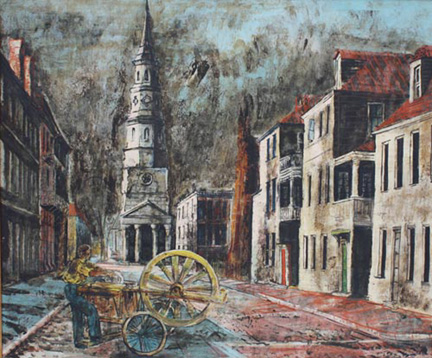
The Gibbes recently acquired a work entitled Church Street, Charleston by Karl Zerbe (1903 – 1972). A German-born artist, Zerbe came to the United States in 1934 to escape Nazi rule. Prior to his arrival in the US, Zerbe was recognized as one of Germany’s most promising young artists. He settled in the Boston area, and in 1936 was named Head of the Painting Department at the Museum School of the Museum of Fine Arts Boston, a position he maintained until 1953. By the 1940s, Zerbe along with his contemporaries Jack Levine and Hyman Bloom achieved national recognition as leaders of the Boston Expressionists School. Zerbe frequently experimented with new painting processes and is credited with reviving the ancient technique of encaustic, a medium which became his mainstay during the 1940s.
Zerbe made his first sojourn to Charleston in 1940, undoubtedly influenced by his relationship with native Charleston artist, William Halsey. Halsey studied under Zerbe at the Museum School in Boston from 1937 to 1939 and credits Zerbe as one his most significant mentors. Painted in the figurative expressionist style, Zerbe’s depiction of Church Street is a unique interpretation of a commonly painted Charleston scene. This painting was first exhibited at the Gibbes in 1962 during a retrospective exhibition of Zerbe’s work organized and traveled by the American Federation of the Arts. Now a part of the Gibbes permanent collection, you can see this exciting new work on view in the Welcome Gallery.
Want to see more of the museum’s collection? Click here to browse our online collections search.
Published November 13, 2009

